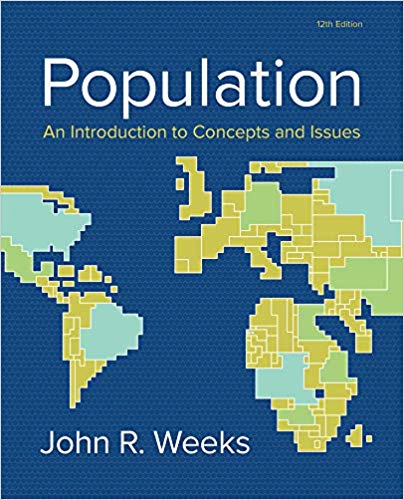Description
Test Bank For Population An Introduction to Concepts And Issues 12th Edition By John R. Weeks
CHAPTER ONE
INTRODUCTION TO DEMOGRAPHY
LEARNING OBJECTIVES
- Understand what the field of demography is all about.
- Understand why demography is important to study—how it connects the dots.
- Heighten the awareness of the relationships between population and resources.
- Comprehend the relationships between population and global events.
- Understand how demographic information can be used.
MAIN POINTS
- Demography is concerned with everything that influences or can be influenced by population size, growth or decline, processes, spatial distribution, structure, and characteristics.
- Almost everything in your life has demographic underpinnings that you should understand.
- Demography is a force in the world that influences every improvement in human well-being that the world has witnessed over the past few hundred years.
- The past was very different from the present in large part because of demographic changes taking place all over the globe; and the future will be different for the same reasons.
- The cornerstones of population studies are the processes of mortality (a deadly subject), fertility (a well-conceived topic), and migration (a moving experience).
- Demographic change demands that societies adjust, thus forcing social change, but different societies will respond differently to these challenges, sometimes for the better, sometimes for the worse.
- Examples of global issues that have deep and important demographic components include the relationship of population to food, water, and energy resources, as well as housing and infrastructure, and environmental degradation.
- Population is also connected to social and political dynamics such as regional conflict, often exacerbated by youth bulges, as well as globalization, the need for immigrants created by the phenomenon of “demographic fit” and then the backlash against those immigrants.
- Changes in the age structure are the most obvious ways in which demography forces societal change and, at the same time, creates business opportunities—exemplified by the idea of “riding the age wave.”
- A key to all demographic trends in the world is the status of women.
EXAMINATION QUESTIONS
Multiple-Choice (Choose the single best answer—the page where the answer is found is indicated in parentheses)
- The modern concept of demography emphasizes the ______ and ______ of population change.
- causes; consequences (3)
- spatial distribution; population structure
- processes; characteristics
- size; growth
- “Hatching, matching, and dispatching” is shorthand for the description of
- population processes. (3)
- population distribution.
- population characteristics.
- none of the above.
- Population structure is defined as
- how many people there are in a given place.
- where people are located and why.
- how many males and females there are of each age. (3)
- what people are like in a given place.
- The concept of the past as a foreign country is based on the idea that
- there used to be fewer foreigners in the United States than there are now.
- the boundaries of the country have changed over the past two hundred years.
- the population structure and characteristics have changed over time. (3)
- immigrants have dramatically changed the demographics of the United States.
- Between 1910 and 2010, life expectancy in the United States increased from about ____ to more than 80.
- 40
- 50 (4)
- 60
- 70
- Between 1910 and 2010, the average number of children born to women in the United States declined from____ to 1.9.
- 5.0
- 4.5
- 4.0
- 3.5 (4)
- Population growth is closely associated with water availability because
- people prefer to live near water.
- water is required to grow more food .(6)
- waterways provide a key source of transportation for people.
- a warming planet will reduce the amount of ground water available per person.
- Population growth alone would not have had such a huge impact on the environment were it not for the accompanying fact that
- people have been living longer.
- there has been an intensive increase in the use of resources. (7)
- the atmospheric conditions have been shifting.
- humans have settled in increasingly vulnerable parts of the planet.
- One of the major demographic forces that is incendiary in the Middle East is
- the high maternal mortality rate.
- high mortality from violent causes.
- refugees leaving the area.
- the impact of the youth bulge. (8)
- The demographic roots of violence in sub-Saharan Africa are related especially to
- the high maternal mortality rate.
- high mortality from violent causes.
- refugees leaving the area.
- the impact of the youth bulge. (9)
- The predominant underlying demographic roots of social unrest in the Middle East and North Africa (MENA) region of the world are especially related to
- religious differences within the region that force women to have children.
- the debilitating impact of dictatorships that raise the death rate.
- population stress on the environment. (10)
- increasing numbers of internally displaced persons.
- As a region, the population of MENA was approximately ____ times greater in 2015 than in 1950.
- two
- three
- four
- five (11)
- Globalization is rooted in demography most clearly as a result of
- migration from developing to richer nations.
- low-wage labor in rapidly growing developing nations. (6)
- the spread of transportation and communication technology.
- the global increase in educational levels.
- The United States accepts more immigrants than any other country in the world, but the country with the highest number of immigrants per person is
- Canada. (10)
- Australia.
- the United Kingdom.
- France.
- Besides Mexico’s proximity to the United States, the migration from Mexico to the United States can be explained best by
- the “demographic fit” between the two countries. (14)
- the deep poverty in Mexico.
- the pervasiveness of drug use in the United States.
- insufficient border control.
- With reference to Europe, the “demographic time bomb” usually refers to
- the rapid growth of the Muslim population.
- the impact of undocumented immigrants from sub-Saharan Africa.
- low fertility leading to the demise of the nuclear family.
- the rapid aging of the population. (15)
- Unlike in the United States, the aging of the population in Japan is not accompanied by a(n)
- rise in life expectancy.
- drop in fertility.
- emptying out of rural villages.
- increase in immigration. (15)
- Population growth and change is most immediately experienced as changes in the ratio of
- successive age groups to each other. (16)
- immigrants to the native-born.
- births to deaths.
- women to men.
- The rise and fall of consumer product sales is closely associated with the ratio of
- successive age groups to each other. (18)
- immigrants to the native-born.
- births to deaths.
- women to men.
- Economic data suggest that a ______ is good for economic growth.
- very youthful population
- rapidly aging population
- population with a disproportionate share of people of working age (20)
- population with a disproportionate share of immigrants
True-False
- The term demography has Greek linguistic roots meaning “people” and “study of.” T (3)
- Between 1910 and 2010 the world’s population increased from 2 to 7 billion. T (3).
- At the beginning of the twentieth century, the percent of the U.S. population that was foreign born was considerably less than it was at the beginning of the twenty-first century. F (4)
- The fact that demography is connected to nearly everything means that demography determines nearly everything. F (5)
- All of the future growth in the world is expected to show up in cities. T (7)
- A youth bulge inevitably leads to conflict in human populations. F (9)
- Globalization has been spurred on by the global decline in death rates after World War II. T (9)
- The crime rate is associated with the age structure because young men are most apt to commit crimes. T (18)
- Life insurance companies and pension funds both make more money the longer that their customers live. F (19)
- The oppression of women in a society will likely be associated with an unfavorable demographic profile for that country. T (21)
ESSAY/CLASS DISCUSSION QUESTIONS
- When did you first become aware of demography or population issues more broadly, and what were the things that initially seemed to be important to you?
- Why is the idea that nearly everything is connected to demography, or the companion idea that demography is destiny, not the same as demographic determinism?
- How do you think the politics of the Middle East and North Africa (MENA) will be influenced in the long term by the changing demographics of the region?
- Discuss the relative advantages and disadvantages of a youth bulge for a society to deal with.
- Because globalization has an underlying demographic component, how might that affect the investing patterns of someone who uses demography as one of their investment criteria?
WEBSITES SUGGESTED FOR THIS CHAPTER
http://www.census.gov The website of the U.S. Census Bureau has many useful features, including U.S. and world population information and U.S. and world population clocks (where you can check the latest estimate of the total U.S. and world populations).
http://www.prb.org The Population Reference Bureau (PRB) in Washington, D.C., is a world leader in developing and distributing population information. The site includes regularly updated information about PRB’s own activities, as well as links to a wide range of other population-related websites all over the world.
http://www.un.org/en/development/desa/population/ The Population Division of the United Nations is the single most important producer of global demographic information, which can be accessed at this site. Closely related United Nations data can be accessed through http://data.un.org.
http://www.poodwaddle.com/clocks/worldclock/ This website keeps track of a wide range of demographic data from various official sources and then produces estimates that are constantly being updated (thus, they are called “clocks”) by extrapolation models.
And, of course, check for the latest items related to this chapter on my blog:
http://weekspopulation.blogspot.com/search/label/Introduction to Demography
OTHER RESOURCES
To follow up on the theme of “the past is a foreign country,” you might assign some or all of Claude S. Fischer and Michael Hout, Century of Difference: How America Changed in the Last One Hundred Years (New York: Russell Sage Foundation), 2006.





Be the first to review “Test Bank For Population An Introduction to Concepts And Issues 12th Edition By John R. Weeks”